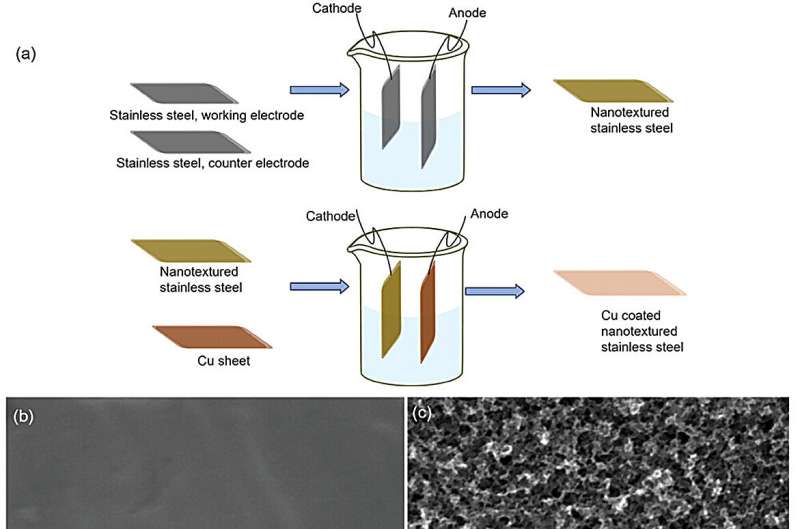An electrochemical process developed at Georgia Tech could offer new protection against bacterial infections without contributing to growing antibiotic resistance.
The approach capitalizes on the natural antibacterial properties of copper and creates incredibly small needle-like structures on the surface of stainless steel to kill harmful bacteria like E. coli and Staphylococcus. It’s convenient and inexpensive, and it could reduce the need for chemicals and antibiotics in hospitals, kitchens, and other settings where surface contamination can lead to serious illness.
It also could save lives: A global study of drug-resistant infections found they directly killed 1.27 million people in 2019 and contributed to nearly 5 million other deaths—making these infections one of the leading causes of death for every age group.
Researchers described the copper-stainless steel and its effectiveness May 20 in the journal Small.
“Killing Gram-positive bacteria without chemicals is comparatively easy but tackling Gram-negative bacteria poses a significant challenge, due to their thick, multilayered cell membrane. And if these bacteria persist on surfaces, they can grow rapidly,” said Anuja Tripathi, the study’s lead author and a postdoctoral scholar in the School of Chemical and Biomolecular Engineering. “I aimed to develop an antibiotic-free bactericidal surface effective against Gram-negative and Gram-positive bacteria.”
Tripathi and her colleagues—William R. McLain Professor Julie Champion and former Ph.D. students Jaeyoung Park and Thomas Pho—produced a one-two punch that overcomes those challenges and doesn’t help bacteria develop resistance to drugs.
The team first developed an electrochemical method to etch the surface of stainless steel, creating nano-sized needle-like structures on the surface that can puncture bacteria’s cell membranes. Then, with a second electrochemical process, the researchers deposited copper ions on the steel’s surface.
Copper interacts with the cell membranes and ultimately compromises them.
“The nanotextured stainless steel can kill both Gram-negative and Gram-positive bacteria, but we wanted to enhance the antibacterial activity for surfaces that can be highly contaminated,” Tripathi said. “The copper coating on the nanotextured stainless steel gave us very high antibacterial activity.”

and c,e) nanotextured stainless steel etched for 30 s at 8 V. Credit: Small (2024). DOI: 10.1002/smll.202311546
Despite copper’s known antibacterial properties, it’s not widely used to fight surface contamination because it’s expensive. Tripathi’s approach deposits only a thin layer of copper ions on the stainless steel, so it’s cost-effective without compromising the material’s antibacterial activity.
Together, the dual attacks resulted in 97% reduction of Gram-negative E. coli and 99% reduction in Gram-positive Staphylococcus epidermis bacteria in the group’s study.
Tripathi said the stainless steel could be used for common tools in medical settings that are easily fouled, such as scissors or tweezers. It could be used for door handles, stair railings, and perhaps even sinks—places where stainless steel is often the material of choice and surface bacteria are common, especially in hospitals or other shared settings.
The process she and her colleagues developed also could be useful in food service. Tripathi said the approach could be fairly easily incorporated into existing industrial processes, where different electrochemical coating methods already are used for stainless steel food storage containers.
Tripathi said future work will investigate if the copper-coated, nanotextured stainless steel is effective against other kinds of cells harmful to human health. She’s also interested in exploring whether the steel could be used for medical implants to help ward off infections.
Since it proved effective against troublesome E. coli, she’s hopeful.
“Reflecting on a recent E. coli outbreak in grocery stores in Calgary, Canada, I was particularly driven in my research, recognizing the urgent relevance and significance of combating such resilient bacteria on surfaces,” Tripathi said. “They can be difficult to eliminate. So, if we can effectively eliminate E. coli, we stand a good chance of eradicating many bacteria on surfaces.”
More information: Anuja Tripathi et al, Dual Antibacterial Properties of Copper‐Coated Nanotextured Stainless Steel, Small (2024). DOI: 10.1002/smll.202311546
Journal information: Small
Provided by Georgia Institute of Technology
News
Lower doses of immunotherapy for skin cancer give better results, study suggests
According to a new study, lower doses of approved immunotherapy for malignant melanoma can give better results against tumors, while reducing side effects. This is reported by researchers at Karolinska Institutet in the Journal of the National [...]
Researchers highlight five pathways through which microplastics can harm the brain
Microplastics could be fueling neurodegenerative diseases like Alzheimer's and Parkinson's, with a new study highlighting five ways microplastics can trigger inflammation and damage in the brain. More than 57 million people live with dementia, [...]
Tiny Metal Nanodots Obliterate Cancer Cells While Largely Sparing Healthy Tissue
Scientists have developed tiny metal-oxide particles that push cancer cells past their stress limits while sparing healthy tissue. An international team led by RMIT University has developed tiny particles called nanodots, crafted from a metallic compound, [...]
Gold Nanoclusters Could Supercharge Quantum Computers
Researchers found that gold “super atoms” can behave like the atoms in top-tier quantum systems—only far easier to scale. These tiny clusters can be customized at the molecular level, offering a powerful, tunable foundation [...]
A single shot of HPV vaccine may be enough to fight cervical cancer, study finds
WASHINGTON -- A single HPV vaccination appears just as effective as two doses at preventing the viral infection that causes cervical cancer, researchers reported Wednesday. HPV, or human papillomavirus, is very common and spread [...]
New technique overcomes technological barrier in 3D brain imaging
Scientists at the Swiss Light Source SLS have succeeded in mapping a piece of brain tissue in 3D at unprecedented resolution using X-rays, non-destructively. The breakthrough overcomes a long-standing technological barrier that had limited [...]
Scientists Uncover Hidden Blood Pattern in Long COVID
Researchers found persistent microclot and NET structures in Long COVID blood that may explain long-lasting symptoms. Researchers examining Long COVID have identified a structural connection between circulating microclots and neutrophil extracellular traps (NETs). The [...]
This Cellular Trick Helps Cancer Spread, but Could Also Stop It
Groups of normal cbiells can sense far into their surroundings, helping explain cancer cell migration. Understanding this ability could lead to new ways to limit tumor spread. The tale of the princess and the [...]
New mRNA therapy targets drug-resistant pneumonia
Bacteria that multiply on surfaces are a major headache in health care when they gain a foothold on, for example, implants or in catheters. Researchers at Chalmers University of Technology in Sweden have found [...]
Current Heart Health Guidelines Are Failing To Catch a Deadly Genetic Killer
New research reveals that standard screening misses most people with a common inherited cholesterol disorder. A Mayo Clinic study reports that current genetic screening guidelines overlook most people who have familial hypercholesterolemia, an inherited disorder that [...]
Scientists Identify the Evolutionary “Purpose” of Consciousness
Summary: Researchers at Ruhr University Bochum explore why consciousness evolved and why different species developed it in distinct ways. By comparing humans with birds, they show that complex awareness may arise through different neural architectures yet [...]
Novel mRNA therapy curbs antibiotic-resistant infections in preclinical lung models
Researchers at the Icahn School of Medicine at Mount Sinai and collaborators have reported early success with a novel mRNA-based therapy designed to combat antibiotic-resistant bacteria. The findings, published in Nature Biotechnology, show that in [...]
New skin-permeable polymer delivers insulin without needles
A breakthrough zwitterionic polymer slips through the skin’s toughest barriers, carrying insulin deep into tissue and normalizing blood sugar, offering patients a painless alternative to daily injections. A recent study published in the journal Nature examines [...]
Multifunctional Nanogels: A Breakthrough in Antibacterial Strategies
Antibiotic resistance is a growing concern - from human health to crop survival. A new study successfully uses nanogels to target and almost entirely inhibit the bacteria P. Aeruginosa. Recently published in Angewandte Chemie, the study [...]
Nanoflowers rejuvenate old and damaged human cells by replacing their mitochondria
Biomedical researchers at Texas A&M University may have discovered a way to stop or even reverse the decline of cellular energy production—a finding that could have revolutionary effects across medicine. Dr. Akhilesh K. Gaharwar [...]
The Stunning New Push to Protect the Invisible 99% of Life
Scientists worldwide have joined forces to build the first-ever roadmap for conserving Earth’s vast invisible majority—microbes. Their new IUCN Specialist Group reframes conservation by elevating microbial life to the same urgency as plants and [...]





















